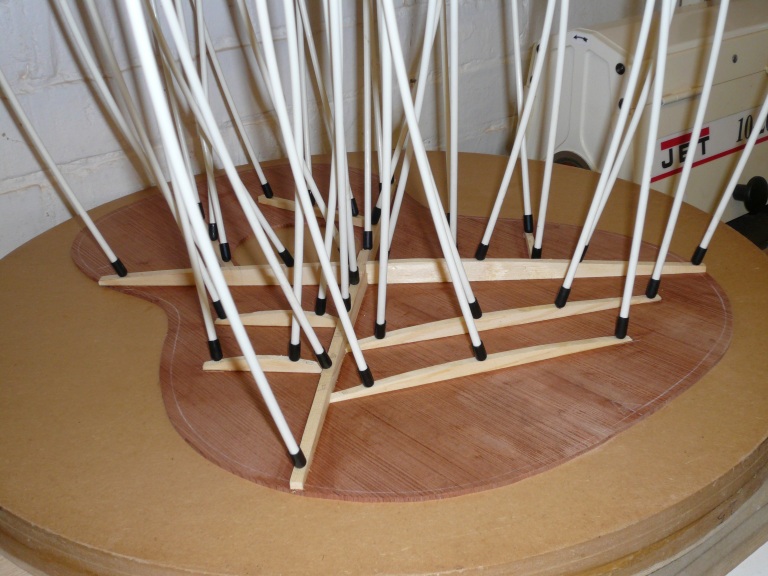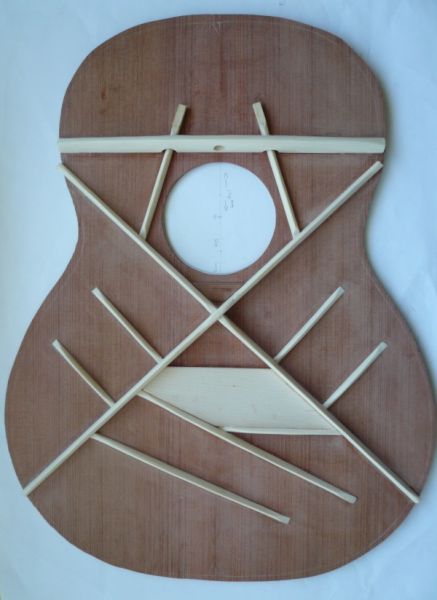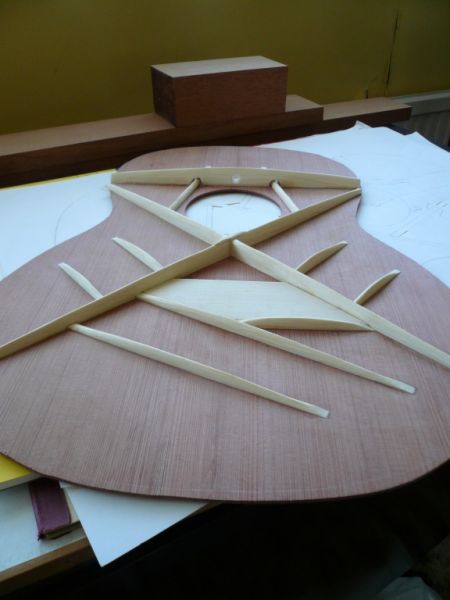Laying Out Parabolic Braces
Laying Out Parabolic Braces
For those who use them, how do you layout the curve along the brace? And do you cut it before or after you glue them on?
- Dave White
- Blackwood
- Posts: 452
- Joined: Mon Nov 12, 2007 3:10 am
- Location: Hughenden Valley, England
- Contact:
Lillian,
I do all of the shaping/carving after the braces are glued on. I do the curves by "eye" and by the tops response when I voice it. I tend to start a few inches past the X brace intersection and pare down to the end of the X legs, taking more off the ends. They tend to end up as a general curve with no big changes of direction.
I do all of the shaping/carving after the braces are glued on. I do the curves by "eye" and by the tops response when I voice it. I tend to start a few inches past the X brace intersection and pare down to the end of the X legs, taking more off the ends. They tend to end up as a general curve with no big changes of direction.
Dave White
[url=http://www.defaoiteguitars.com]De Faoite Stringed Instruments[/url]
[url=http://www.defaoiteguitars.com]De Faoite Stringed Instruments[/url]
I do a rough shaping of the braces before glueing up. I keep most of the hight in front of the X-brace right up to the linings, and just a gradual taper south of the x-brace to the bridge patch, then generally there is a steeper taper, depending on tops stiffness etc. I don't inlet the south ends of the x-brace. They just feather out into the soundboard a millimeter or so from the linings.
Same here Lillian my friend. I shape the braces on the top too and the general shaping is done from memory and then I let the top or back tell me what adjustments that I need to make.
I think that it's easy to get caught up in the term "parabolic" when, at least in my case, I am really speaking of tapered, not scalloped braces.
I glue up the X brace stock and then shape the X braces with some voicing before any other braces are installed. Then I add a couple of more braces and shape, voice, and move on to more braces. The last thing that I glue in place is the bridge plate, voice the top again and adjust as required.
Probably 90% of my shaping is done with a finger plane(s) with the chisels only used for the brace ends and to remove excess material near the X intersection where the planes can't get in close.
The only things that I inlet are the upper transverse brace and the upper X legs. Colin inlets the lower X-legs too and I have been thinking of going back to this method.
A good starting point is to determine how high you want the X-intersection for the guitar style and size that you are making. I use 1/2" for say an OM. From that high spot, the X-intersection, I taper the braces toward the ends also leaving more height in front of the X-intersection. Then most of my time shaping is spent achieving sharp triangular profiles.
When tapping and voicing when I encounter a dead spot I try to remove, if any is available, excess brace mass from the sides of the braces where I hear a dead spot. If that does not kill the dead area I take off a little height, reprofile the sides of the braces to get the triangular profile again, tap and see if that improves the response. It usually does too.
I think that it's easy to get caught up in the term "parabolic" when, at least in my case, I am really speaking of tapered, not scalloped braces.
I glue up the X brace stock and then shape the X braces with some voicing before any other braces are installed. Then I add a couple of more braces and shape, voice, and move on to more braces. The last thing that I glue in place is the bridge plate, voice the top again and adjust as required.
Probably 90% of my shaping is done with a finger plane(s) with the chisels only used for the brace ends and to remove excess material near the X intersection where the planes can't get in close.
The only things that I inlet are the upper transverse brace and the upper X legs. Colin inlets the lower X-legs too and I have been thinking of going back to this method.
A good starting point is to determine how high you want the X-intersection for the guitar style and size that you are making. I use 1/2" for say an OM. From that high spot, the X-intersection, I taper the braces toward the ends also leaving more height in front of the X-intersection. Then most of my time shaping is spent achieving sharp triangular profiles.
When tapping and voicing when I encounter a dead spot I try to remove, if any is available, excess brace mass from the sides of the braces where I hear a dead spot. If that does not kill the dead area I take off a little height, reprofile the sides of the braces to get the triangular profile again, tap and see if that improves the response. It usually does too.
Lillian, I do put a rough longitudinal shape on the top of the 'parabolic' braces before I glue them to the top. As you can see here they are not all the same profile.

The peaks of the 'parabola' are in different places according to the position of the brace. The upper tone and finger bars have the peak approximately one third of the distance from the X brace and the lower tone and finger the peak is halfway from the X.
I've found this to be an almost constant after about 25 or so tops using this system. All of my braces are inlet into the X as I'm trying to build a single bracing network on the top rather than discrete separate braces.
After I roughly put the lateral shape to the braces the top is then tuned by tapping along the top over the braces and adjusting as necessary, but always maintaining the general profile. Sometimes I tuck the lower X legs, sometimes I don't. Final tuning of the top for me takes place after the bridge and strings are put on so I can test the top's response and sand/thin the top as necessary, but I rarely have to make any further adjustments to the braces.


Colin

The peaks of the 'parabola' are in different places according to the position of the brace. The upper tone and finger bars have the peak approximately one third of the distance from the X brace and the lower tone and finger the peak is halfway from the X.
I've found this to be an almost constant after about 25 or so tops using this system. All of my braces are inlet into the X as I'm trying to build a single bracing network on the top rather than discrete separate braces.
After I roughly put the lateral shape to the braces the top is then tuned by tapping along the top over the braces and adjusting as necessary, but always maintaining the general profile. Sometimes I tuck the lower X legs, sometimes I don't. Final tuning of the top for me takes place after the bridge and strings are put on so I can test the top's response and sand/thin the top as necessary, but I rarely have to make any further adjustments to the braces.


Colin
"In 1969, I gave up alcohol and women, worst 20 minutes of my life." George Best.
Who is online
Users browsing this forum: No registered users and 181 guests